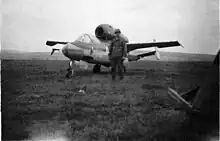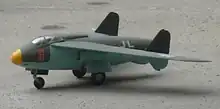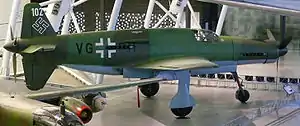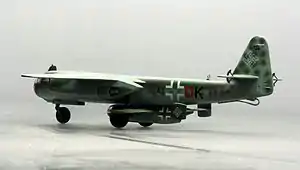

The Emergency Fighter Program (German: Jägernotprogramm) was the program that resulted from a decision taken on July 3, 1944 by the Luftwaffe regarding the German aircraft manufacturing companies during the last year of the Third Reich.
This project was one of the products of the latter part of 1944, when the Luftwaffe High Command saw that there was a dire need for a strong defense against Allied bombing raids. Although opposed by important figures such as Luftwaffe fighter force leader Adolf Galland, the project went ahead owing to the backing of Reichsmarschall Hermann Göring.[1] Most of the designs of the Emergency Fighter Program never proceeded past the project stage.
History
1944 began with massive bombing raids by the US Army Air Force and RAF Bomber Command on a unprecedented scale. With a shift of emphasis from targeting strategic targets to the destruction of the Luftwaffe, during the Big Week in late February 1944 the Luftwaffe fighter force was broken. Attempts to address this failed, and by the summer, Allied aircraft were roaming at will over most of Germany.
The Messerschmitt Me 262, then about to enter service, had a clear performance advantage over the Allied aircraft but were expensive and difficult to keep operational. This led to the idea of a much simpler design which could be easily built and so inexpensive that any extensive problems would be addressed by simply disposing of the aircraft. This became the genesis of the Emergency Fighter Program as part of shifting production to defensive interceptor/fighters. A number of new aircraft design competition programmes were launched to provide new designs.

Production of the Messerschmitt Me 262A fighter versions continued, as did the development of advanced piston-engined fighters such as the Dornier Do 335 as per Hitler's personal request on May 23, 1944, before the July 3 announcement of the program. Bomber designs powered by piston engines were curtailed or cancelled, with only jet bombers such as the Arado Ar 234 allowed to continue in production. New jet bombers such as the Junkers Ju 287 and Heinkel He 343 were worked on fitfully as low priority projects in the last months of the war.
Towards the end of the war the design of aircraft largely ignored the safety or comfort of the pilots, who would be mostly Hitler Youth motivated by fanaticism. Some of the fighters, such as the Heinkel P.1077 Julia, the Blohm & Voss BV 40 and the Arado E.381 Kleinstjäger – "smallest fighter" were designed with the pilot flying the aircraft in a prone position. Powered by rockets, certain designs were a blend of "aircraft and projectile" in the words of Nazi propaganda, with a vertical takeoff like a missile launch system attempted for the first time in a crewed aircraft, such as the Bachem Ba 349 Natter —in which the test-pilot died in the first flight.[2] The Natter and Julia designs were expected to climb to their ceiling at vertical or near vertical angles, while the Arado design was a parasite aircraft that needed to be carried by a "mother" plane, with the unpowered BV 40 needing an aerotow into action.

These small interceptors had fuel for only a few minutes of combat and landing was hazardous, for after expending the rocket fuel the center of gravity would have shifted substantially, making the aircraft difficult to handle at best and uncontrollable at worst. In the Natter or the Fliegende Panzerfaust the pilot had to bale out at the end of a mission, while the rear fuselage containing the rocket motor descended under its own parachute. Other designs, such as the Focke-Wulf Volksjäger 2, sought to overcome this problem by means of a very short fuselage. Instead of having a wheeled undercarriage most rocket-powered aircraft had only a fixed skid.[2]
During this period the Nazi authorities also considered the use of selbstopfer (suicide) planes such as the Reichenberg (a piloted version of the V-1 flying bomb),[2] and in one case of actual use, a "special detachment" unit dedicated to desperate aerial ramming tactics, known as Sonderkommando Elbe.
Peoples' Fighter Project
In August 1944, a requirement led to the Volksjäger ("Peoples' Fighter") design competition, intended to create a lightweight high-speed fighter/interceptor using a single BMW 003 turbojet engine,[3] and intended for rapid mass-production while using minimal resources. The Volksjäger was intended to be disposable, with damaged aircraft being discarded rather than repaired, and was to be flown by pilots hastily trained on gliders.
After a hurried design competition involving almost all German aircraft companies Heinkel's He 162 was selected.[4] The first prototype flew in December 1944.[5] Other designs submitted to the Peoples' Fighter Programme, such as the Blohm & Voss P 211, were potentially superior but were never proceeded with.
Miniature Fighter Project

In November 1944 a programme for an even simpler fighter, the so-called Miniaturjägerprogramm ("Miniature Fighter Program") was initiated. The aim was to produce a very small interceptor using the absolute minimum of strategic materials. Stress was laid on producing the aircraft cheaply and in large numbers so as to overwhelm the Allied bombers.[2] The Miniaturjäger was to be powered by a single Argus As 014 pulsejet engine, since building this engine required far fewer man-hours than the 375 man-hours[6] needed to build a Junkers Jumo 004 turbojet.[7] The various German aircraft designers showed less interest in this new enterprise than in the Peoples' Fighter Project, since the imminent He 162 program would use most of what was left of the country's production capacity. Furthermore, it was already well known by the time the competition was announced that, since they didn't produce enough power at low speeds for takeoff, the Argus pulsejets were unsuitable for crewed aircraft which would have to take off unassisted. Since additional launch schemes would have to be added to the project, such as towplanes, catapults or rocket boosters, the goal of the program would be defeated as complexity and expense would be far higher.[1] Thus the Miniaturjäger project never saw mass-production, being abandoned by December 1944.
Nevertheless Heinkel, Blohm & Voss and Junkers came up with light fighter designs using a strict minimum of materials before that date. The resulting planes were small, spartan creations, with no radio and almost no electrical equipment, Heinkel would use a He 162 air frame powered by a pulse jet, Blohm & Voss designed the BV P 213 and Junkers would submit the Ju EF 126 Elli project. The only Miniature Fighter aircraft to get beyond blueprint status was the Junkers EF 126. Although unbuilt during the war, five prototypes were built in the Dessau Junkers plant in the area occupied by the Soviet Union. One of the prototypes was destroyed during unpowered testing in 1946, killing the pilot.[8]
Other projects
At the beginning of 1945 a further programme was launched by the OKL in order to replace the He 162 Volksjäger. The new aircraft was intended to have superior performance in order to deal with future high altitude threats such as the B-29 Superfortress.</ref> To meet this requirement, power was to be a single Heinkel HeS 011 turbojet, of which only 19 examples were ever produced, and all allocated for development testing. The designs of the Messerschmitt P.1110, Heinkel P.1078, Focke-Wulf Ta 183, Blohm & Voss P 212 as well as the official winner of the competition, the Junkers EF 128, were submitted by February 1945.[9]
Only the Messerschmitt prototype of this more advanced fighter had been started by the end of the war.[10] The first prototype of the Messerschmitt P.1101 was 80% complete when captured at the end of the war, following which it was taken to America, with some of its design ideas used as the basis of the Bell X-5 variable geometry research aircraft.[11]
List of projects
Gliders
Pulsejet
- Blohm & Voss P 213
- Junkers EF 126 Elli
- Heinkel He 162 B
- Heinkel P.1077 Romeo
- Messerschmitt Me 328
- Messerschmitt P.1079 1, 2, 10c, 13b, 15 and 16
Ramjet
Rocket
- Arado E.381 Kleinstjäger
- Bachem Ba 349 Natter
- Blohm & Voss P 214
- DFS Eber, parasite fighter project
- DFS Rammer, aerial ramming plane project
- Focke-Wulf Volksjäger 2
- Heinkel P.1077 Julia
- Junkers EF 127 Walli
- Messerschmitt P.1103
- Messerschmitt P.1104
- Sombold So 344
- Stöckel Rammschussjäger aerial ramming plane project
- Von Braun Interceptor, planned by von Braun[12]
- Zeppelin Fliegende Panzerfaust
- Zeppelin Rammer
Turbojet
See also
References
- 1 2 The Heinkel He-162 Volksjaeger
- 1 2 3 4 Ulrich Albrecht. "Artefakte des Fanatismus; Technik und nationalsozialistische Ideologie in der Endphase des Dritten Reiches". Wissenschaft & Frieden 1989-4. Retrieved March 22, 2017.
- ↑ Christopher, John. The Race for Hitler's X-Planes (The Mill, Gloucestershire: History Press, 2013), p.145.
- ↑ Smith and Kay 1972, pp. 307–308.
- ↑ Smith and Kay 1972, p.308.
- ↑ Christopher, John. The Race for Hitler's X-Planes (The Mill, Gloucestershire: History Press, 2013), p.75.
- ↑ Smith and Kay 1972, p.614.
- ↑ Junkers Ef-126 "Lilli"
- ↑ Karl-Heinz Ludwig, Technik und Ingenieure im Dritten Reich. Athenäum-Verlag, Königstein/Ts., 1979, ISBN 3761072198
- ↑ Smith and Kay 1972, pp. 626–628.
- ↑ Smith and Kay 1972, pp. 622–624.
- ↑ Von Braun Interceptor
Bibliography
- Smith, J.R. and Kay, Antony L. German Aircraft of the Second World War. London: Putnam, 1972. ISBN 0-85177-836-4.
